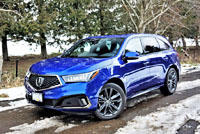
What? You don’t know what an A-Spec is? It’s ok. Sometimes I forget that normal people don’t follow the auto industry as closely as car enthusiasts and journalists like me. A-Spec is Acura’s sport-oriented styling package that may or may not include real performance upgrades. With respect to the new 2019 MDX A-Spec, it’s all about the look.
That look starts with glossy black and dark-chrome detailing for the grille, headlights, window trim, and tailgate spoiler, plus a bolder front fascia design, painted front and rear lower skid plate garnishes, body-coloured outer door handles, body-colour lower side sills, larger-diameter exhaust finishers, and a near equally darkened set of 20-inch 10-spoke Shark Grey alloy wheels on lower profile 265/45 rubber. Those tires might seem like the only exterior upgrade that could potentially enhance performance, but then again it’s the same used on the MDX’ most luxuriously appointed Elite trim.
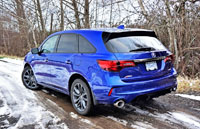
Stepping inside means you’ll pass overtop one of four A-Spec-branded aluminum doorsill garnishes, while additional interior enhancements include a special primary gauge cluster embellished with more red on the rev and speed markers, a thicker-rimmed A-Spec-badged steering wheel featuring a dimpled leather wrap on its lower three-quarters, metal sport pedals, unique carbon-look console trim, and sport seats upholstered in “Rich Red” or in the case of my tester, black leather with perforated black suede-like Alcantara inserts plus high-contrast stitching.
I like the visual changes made inside and outside, the latter giving new life to a still handsome yet aging design, and the former also masking an SUV that’s starting to look like yesteryear’s news now that the all-new RDX has arrived. By that I’m not saying for a second that Acura should swap out the MDX’ lower console-mounted pushbutton gear selector for the bizarre contraption clinging to the RDX’ centre stack, nor for that matter the smaller SUV’s big space-robbing drive mode selector dial housed just above the gear selector switchgear, but the sizeable multi-information display (MID) within the otherwise analogue gauge cluster does a reasonably good job of modernizing the look (a fully digital design would be better) and the single fixed tablet-style infotainment display atop the RDX dash is a major improvement over the double-stacked MDX design in every way, except for its lack of touchscreen capability.
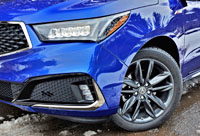
By comparison, the MDX’ MID is a thin sliver of remedial graphics and passable info, lacking the wow-factor of an Audi Virtual Cockpit that transforms into a massive map just by pressing a steering wheel-mounted button, or for that matter the new 2020 Mercedes GLE/GLS that does away with a traditional gauge binnacle altogether, instead melding two big tablet-style screens together and using the left-side for driver info and the right-side for touch-actuated infotainment. Back to Acura reality, the MDX uses the two-tiered combination of displays just noted, the top 8.0-inch monitor more of a true MID that’s controllable via a rotating dial just under the bottom display, although defaulting to the navigation system’s map/route guidance info most of the time, and multi-angle rearview camera with dynamic guidelines when in reverse; the overhead 360-degree surround camera is reserved for aforementioned Elite trim. This said, the lower 7.0-inch display is a touchscreen and quite utile, providing easy control of the audio and HVAC systems, plus more.
While some of my comments might sound as if I’m getting down on Acura and its MDX, it’s clearly not alone, as in-car digitalization is one of the most comprehensive transformations being undertaken by the auto industry today. After years of getting it wrong, some are now getting it right, while Acura is getting close with its most recent designs, and obviously requires modernization within some of its older models, like this MDX.
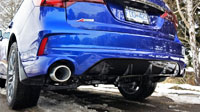
This brings up an important point, the MDX will most likely be completely redesigned next year as a 2021 model, at which point we hope it takes a few cues from the aforementioned Mercedes pair, Volvo’s XC90, and some others, by integrating both a touchscreen like the current MDX, as well as a touchpad like that in the RDX, the latter for those who’d rather not reach so far. For the time being the MDX two-screen setup does the trick, but of course buyers of the latest MDX won’t go home feeling like they’ve just traded in their old Samsung Note 4 for a new Note 10 (or for you Apple fans, swapping the old iPhone 6 for the new XS Max).
Speaking of Google and iOS operating systems, the base MDX infotainment system includes Android Auto and Apple CarPlay, plus Bluetooth phone and audio streaming, Siri Eyes Free, SMS text message and email reading capability, satellite radio, and four USB charging ports, while this A-Spec model sources its navigation with voice recognition from mid-range Tech trim, which also adds an impressive sounding 10-speaker ELS Studio surround audio system, hard disk drive (HDD) media storage, and AcuraLink subscription services to the in-car electronics experience.
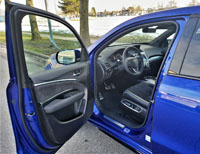
It’s so tempting to prattle on about features, because each trim provides such a lengthy list that the MDX’ value proposition becomes immediately clear, so suffice to say that additional items not yet covered on the $60,490 A-Spec include LED fog lights, auto-dimming power-folding side mirrors, perimeter/approach puddle lamps, keyless access buttons on the rear doors, and ventilated/cooled front seats, while other features pulled up from Tech trim include a sun position detection system for the climate control, front and rear parking sensors, plus Blind Spot Information (BSI) with rear cross traffic monitoring.
Speaking of advanced driver assistive systems, all MDX trims come standard with AcuraWatch, a comprehensive suite of safety goodies including Forward Collision Warning (FCW), Collision Mitigation Braking System (CMBS), Lane Departure Warning (LDW), Lane Keeping Assist (LKAS), Road Departure Mitigation (RDM), and Adaptive Cruise Control (ACC) with low-speed follow.
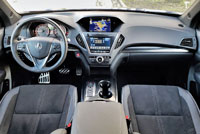
Lastly, a shortlist of key features from the $54,390 base MDX incorporated into the A-Spec include signature Jewel Eye LED headlights with auto high beams, LED taillights, acoustic glass, a heated windshield, remote start, proximity keyless access, pushbutton ignition, ambient lighting, memory for the steering column, side mirrors and climate control, an electromechanical parking brake, a powered moonroof, a HomeLink universal remote, an auto-dimming rearview mirror, driver recognition, a power tilt and telescopic steering column, a heated steering wheel with paddle shifters, rain-sensing wipers, tri-zone front and rear automatic climate control, Active Noise Control (ANC), Active Sound Control (ASC), heated 12-way powered front seats with four-way lumbar, a powered tailgate, a 1,588-kilo towing capacity (or 2,268 kg with the towing package), and more.
Important to you, all 2019 Acura MDX trim, package, and options prices was sourced right here on CarCostCanada, where you can also find helpful rebate information as well as dealer invoice pricing that could save you thousands, so make sure to check it out our many useful features matter which vehicle you end up purchasing.

Along with all of the just noted features and previously mentioned A-Spec interior upgrades, the steering wheel of which is especially nice thanks to its thick textured leather rim and nicely carved thumb spats, is a tasteful assortment of satin-silver finish aluminum accents, plus high-quality soft-touch synthetics across the dash top, door uppers (the door inserts upgraded with plush ultrasuede, like the seats, in A-Spec trim), and most everywhere else including the glove box lid, with only the left portion of the panel below the driver’s knees, the sides of the lower console, and the lower half of the door panels finished in more commonplace hard plastics.
As it should, but is not always the case with some MDX rivals, the driver’s seat features previously noted four-way powered lumbar for optimal lower back support, plus all of the usual adjustments in this class, but I would’ve appreciated an extension for the lower squab to add comfort and support below the knees, even if this were manually adjustable, while some other manufacturers also include adjustable side torso bolsters. As it is, even this sporty A-Spec trim doesn’t provide all that much lateral seat support, but they should work for wider body types that sometimes find more performance-oriented seat designs uncomfortable.
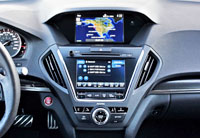
With the driver’s seat positioned high to maximize my view, being just five-foot-eight, I found the rear seating position more than adequately spacious for legs and feet, even while wearing big winter boots. The second row slides back and forth easily, and when all the way forward I still had a few inches between my knees and the driver’s seatback, and when positioned all the way rearward I found second-row legroom quite generous with about eight inches ahead of my knees.
The MDX’ third row only works for smaller folk and children when the second row is pushed all the way back, but when slid forward I was able to sit in the very back without my knees rubbing the backrest ahead, plus those just noted winter boots fit nicely below. I wouldn’t go so far as to call the third row comfortable, but it was workable. Rearmost passengers can also see out a small set of side windows, so it’s not claustrophobic either, plus they get cupholders to each side and nice reading lights overhead. Getting out when in the very back is easy too, only requiring the push of a seatback button that automatically slides the second-row forward, but I wouldn’t say this is the easiest third row to climb in or out of, due to very little space between the folded second-row seatback and door jam.
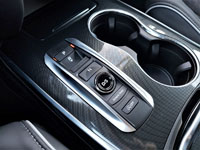
Back in the MDX’ second row of seats, Acura provides a separate climate control interface for rear passengers, with two USB device chargers underneath. Being that my tester was in A-Spec trim there were no second-row outboard seat warmers included, which is a bit of a shame for those who want all the luxury features together with this model’s sportier demeanor.
The rear hatch is powered of course, opening up to a nicely finished cargo compartment that’s dotted with chromed tie-down hooks and covered in quality carpeting all the way up the sidewalls and seatbacks, plus adorned with some attractive aluminum trim on the threshold. There’s a reasonable amount of luggage space behind the third row at 447 litres (15.8 cubic feet), plus a handy compartment under the load floor, and while easy to fold down manually there’s no powered operation for getting them back up. Likewise the second row is purely manual, and while fairly easy to drop down, a process that expands the 1,230 litres (43.4 cu ft) behind the second row seatbacks to a maximum of 2,575 litres (90.9 cu ft) when all seats are lowered, but there’s no centre pass-through for longer items like skis. This means the MDX doesn’t offer the same type of seating/cargo flexibility as the majority of European competitors.
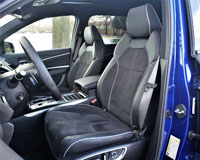
The well-proven powertrain is a bit lacklustre too, even when compared to competitors’ base engines. Acura has been producing the same SOHC 3.5-litre V6 since 2014, making a modest 290 horsepower and 267 lb-ft of torque, and before that, in the previous 2007-2013 second-generation MDX, they used a 3.7-litre version of this engine that (believe it or not) made 10 horsepower and 3 lb-ft of torque more for a total of 300 hp and 270 lb-ft, so effectively they’ve been going backwards when it comes to performance.
Of course, introducing the highly efficient nine-speed ZF automatic with this latest third-generation MDX in 2014 made the less potent engine feel livelier, although it still suffers from a Honda family hauler pedigree when compared to the base 333-hp Audi Q7 mill, the base 335-hp BMW X5, and some others.
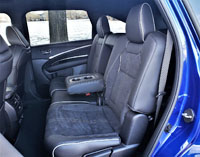
Then again, its performance is decent enough and its pricing a lot lower than those highfalutin Europeans, while the just noted standard nine-speed autobox is fairly quick shifting and very smooth, with the aforementioned standard steering wheel paddle shifters enjoyable to use, plus the standard torque-vectoring SH-AWD system is extremely well engineered and therefore performs superbly no matter the road or weather conditions.
To be clear, the MDX, even in this sportier A-Spec trim, is biased toward comfort over performance. This doesn’t mean it’s a sloth off the line, or cumbersome through corners, but instead is easily fast enough for most peoples’ needs, as proven by its reasonably strong sales numbers year after year, and handles commendably when pushed hard through tight weaving corners, yet never tries to pass itself off as a sport sedan for seven, like some of its Euro rivals do quite effectively. Instead, the MDX’ ride is pleasurable no matter the road surface beneath, its manners particularly nice around town where it sits high above the majority of surrounding traffic and provides excellent visibility through all windows, and its creature comforts plentiful.
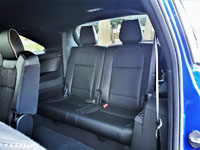
One of those features, specific to performance, is a drive mode selector that includes Comfort, Normal, and Sport settings that remain as selected even after shutting off the engine, locking up and leaving, coming back, and restarting. Therefore, if you personally prefer driving in Sport mode, which I’m going to guess most people who purchase this sportier looking A-Spec model do, then the drivetrain is ready and waiting without any extra effort every time you climb inside.
Another MDX attribute I can attest to is its prowess over snowy roads. This thing is a beast, and with proper snow tires can overcome nearly any depth of powdery (or chunky, wet) white stuff. The latter was addressed with a set of 265/ 45R20 Michelin Latitude Alpin all-season tires, so I can only guess it would even be more formidable when shod in true winters.
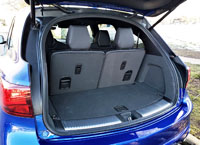
Another positive is real-world fuel economy, which actually benefits from a one-size-fits-all V6 under the hood, especially when burdened by a three-row SUV weighing in at 1,945 kilos (4,288 lbs); the A-Spec the second heaviest trim in the MDX lineup. Thanks to direct-injection, i-VTEC, and Variable Cylinder Management (VCM) that shuts one bank of cylinders down under light loads to save fuel, plus standard engine idle stop-start to reduce consumptions yet more, not to mention emissions, and lastly the nine-speed autobox, the A-Spec is rated at 12.2 L/100km in the city, 9.5 on the highway and 11.0 combined, which is only a tad more than all other MDX trims that get a claimed rating of 12.2 L/100km city, 9.0 highway and 10.8 combined. On the subject of efficiency, I should also mention the much more interesting MDX Sport Hybrid that, thanks to a two-motor electrified drivetrain is good for 9.1 L/100km city, 9.0 highway and 9.0 combined. I’ll cover this model soon, so stay tuned.
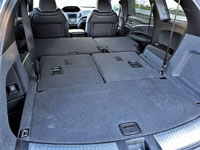
So there you have it, an honest, straightforward review of an aging albeit still credible three-row luxury SUV, that I can still recommend you purchasing if you’re not one of the luxury sector’s usual latest-and-greatest consumer. Let’s face it. The MDX isn’t the newest kid on the block. Its powertrain is archaic compared to the turbocharged and supercharged 316-hp 2.0-litre four-cylinder in the aforementioned Volvo XC90, which can be upgraded to 400-hp plug-in hybrid specs no less, or for that matter the supercharged 3.0-litre V6 in the Audi Q7, and the list goes on, while its infotainment works well enough yet is seriously lacking in modernity, but as long as you’re ok with some aging issues the MDX provides everything families in this class need, and does so in a stylish, refined, quiet, comfortable, spacious, safe, and reasonably reliable package, all for thousands less than any of the noted competitors. That should be reason enough to keep the MDX on your radar when it comes time to trade up, and when you do I recommend checking out this sportier A-Spec trim, because the styling updates and interior details are certainly worth the extra cost.
Story credit: Trevor Hofmann
Photo credit: Karen Tuggay
